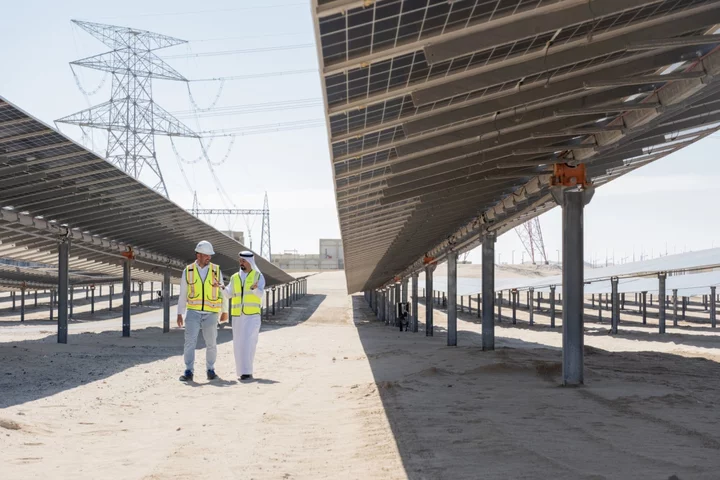As world leaders descend on Dubai for this year’s biggest climate conference COP28, the United Arab Emirates is pushing for a global commitment to triple renewable energy deployment by the end of the decade. It will also showcase its own investments in solar and wind power.
But a closer look at the numbers shows the UAE’s homegrown renewables champion isn’t the giant it claims — at least not yet.
The UAE was among the first of the Middle East’s major oil exporters to start thinking about the end of fossil fuels. In 2006, it founded Abu Dhabi Future Energy Company (Masdar) under the management of Sultan Al Jaber, who’s now president of COP28. (He also remains Masdar chairman and chief executive officer of the Abu Dhabi National Oil Co.)
Masdar, which operates renewable projects in the US and the UK as well as the UAE, now claims it has “more than 20 gigawatts of total clean energy production capacity” and that it is “one of the world’s largest renewable energy companies.”
If its portfolio is indeed that large, then Masdar would rank 11th in BloombergNEF’s ranking of companies that own renewable energy projects. That would put it just below big global names such as Spain’s Iberdrola SA and Italy’s Enel SpA.
But the reality is that Masdar’s portfolio accounts for a little more than 3.8 gigawatts, BNEF data show. That ranks it 62nd in the world among renewable-energy companies, below India’s NTPC Ltd., which also owns one of the world’s largest fleets of coal power plants.
To build its ranking system, BNEF tracks renewable assets and finance around the world. It’s done that for almost 20 years as “a keeper of records,” said David Hostert, global head of economics and modeling at BNEF. “In terms of the breadth and depth of coverage, this is the most complete data set.”
Most renewable-energy projects in the world have multiple owners. Typically, a developer would build a solar or wind farm and then sell stakes to investors. BNEF sums up only equity portions in projects in order to calculate the ranking of companies with the largest portfolio.
For example, the Al Dhafra solar farm in the UAE has a stated capacity of 2,101 megawatts. Masdar has a 20% stake, which means BNEF assigns the net capacity of 420.2 megawatts to Masdar’s portfolio. BNEF notes 46 projects in 14 countries with Masdar’s equity stakes and they add up to 3,824 megawatts.
Masdar calculates the sum of its portfolio differently. It chooses to use gross capacity, meaning the Al Dhafra project counts as 2,101 megawatts in its total portfolio. Bloomberg Green added up all the projects on Masdar’s portfolio on its website according to this methodology and the sum came to 10 gigawatts—about half the company’s claimed capacity.
What explains the difference? A spokesperson for Masdar said that it includes all projects that are “operational, under construction or secured.”
But over the years, BNEF has found that many projects that are announced by developers do not get built or end up being smaller in capacity. Thus it uses only operational capacity for ranking developers.
“There is no uniform ranking system for this sector,” said Masdar’s spokesperson. “We are world leaders by geographic diversification, technological diversification as well as capacity.” The company did not share details of the projects that address the gap between the 10 gigawatts of projects on its website and the 20 gigawatts it claims for the full portfolio.
--With assistance from Demetrios Pogkas.

